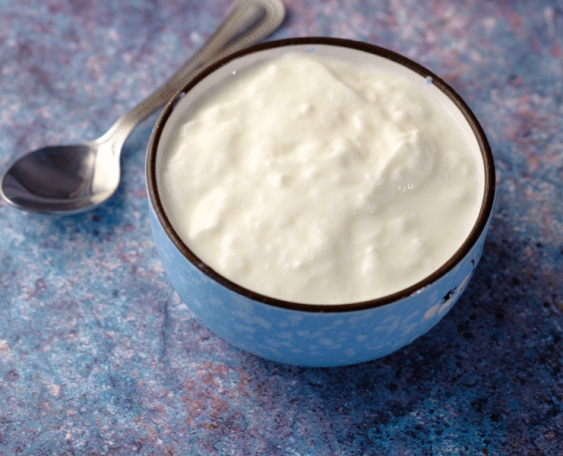Why is it Harmful When Yogurt Sits Out?
Foods that contain high levels of moisture provide an ideal environment for bacteria and other pathogens. Pathogenic organisms generally die or stop multiplying when the temperature is too hot or cold. The temperature range of 40–140 °F is known as the “danger zone” because it provides ideal conditions for bacteria to flourish. In fact, bacteria populations can double every 20 minutes while in the danger zone.
Types of bacteria that proliferate at room temperature yogurt are normally undetectable by taste, sight, or smell. If you eat yogurt that has been sitting out for too long, you could unknowingly consume pathogenic microorganisms that can cause severe illness.
What Kinds of Bacteria Can Grow on Yogurt?
Yogurt may harbor the following types of toxic bacteria:
- Salmonella
- Listeria
- E. Coli
- Staphylococcus aureus (Staph)
- Bacillus cereus (gram-positive bacteria)
- Botulism
- Campylobacter
These bacteria can lead to dangerous foodborne illnesses. Botulism is among the most dangerous and can lead to life-threatening nerve damage and respiratory failure.
Symptoms of food poisoning include diarrhea, vomiting, abdominal pain, bloody diarrhea, muscle weakness, and fever. While most people recover, those with reduced immunity have a heightened risk of developing life-threatening complications. Vulnerable populations include the elderly, young children, and people with immunocompromising disorders.
Do Beneficial Bacteria in Yogurt Stop Harmful Bacteria?
Not all bacteria are bad for you. You may be aware that yogurt is a probiotic that promotes the growth of many beneficial bacteria, such as Lactobacillus bulgaricus bacillus and Streptococcus thermophilus. These bacteria combat harmful bacteria strains in the intestinal tract and are associated with numerous health benefits.
However, the beneficial bacteria in yogurt offer no direct protection against Salmonella, Listeria, or other harmful bacteria outside the body. They only target the types of bacteria that naturally occur inside the body.
Signs That Yogurt Has Gone Bad
Yogurt sitting out may not show any signs of spoilage, so it is important not to assume it is safe to eat just because you cannot see or smell changes. However, yogurt sometimes does show obvious signs of spoilage if kept for too long, even in the refrigerator. Signs of spoiled yogurt include:
- Excessive liquid formation
- Mold
- Rancid smell
- Bad taste
The appearance, taste, and smell of spoiled yogurt are enough to deter most people from consuming it. If consumed, it can cause severe gastrointestinal illness. Organisms that lead to spoilage in yogurt include mold, yeast, and slow-growing bacteria.
Different Types of Yogurt
Yogurt is available in a variety of forms, but no matter what form you buy, it is still a high-moisture food that becomes unsafe if left out for longer than two hours. This includes Greek yogurt, drinkable yogurt, flavored yogurt, plain yogurt, and even non-dairy yogurt. Yogurt with added sugar or fruit may grow bacteria faster because bacteria feed on sugar.
How Long Can Unopened Yogurt Sit Out?
Both opened and unopened yogurt should not be left out at room temperature for more than two hours. For unopened yogurt, this guideline helps ensure the product remains safe to consume until its expiration date when stored properly afterward. Once opened, yogurt is more susceptible to contamination and should be consumed within two weeks days if refrigerated.
Examples of Yogurt Outbreaks and Recalls
In February of 2024, a Listeria outbreak prompted Rizo-Lopez Foods to recall products sold under 29 brand names throughout the country. Tio Francisco yogurt was included in the recall. The outbreak sickened 26 people, resulting in 23 hospitalizations and two deaths.
In 2021, health officials in Washington state traced an E. coli outbreak to the Pure Eire and PCC Community Market brands of yogurt. It affected 17 people and resulted in 10 hospitalizations.
How to Safely Store Yogurt
Always store yogurt in the refrigerator, and make sure your refrigerator is set to 40 °F or lower. Store yogurt toward the back and away from the door, where the temperature is warmer and less stable. Avoid eating out of the container and use a clean spoon to scoop the yogurt if not consuming it all in one sitting.
If your yogurt has been left out for longer than two hours, you cannot make it safe by storing it in the refrigerator. Refrigeration may not kill proliferated bacteria, which can keep multiplying in the refrigerator, just more slowly. If left out for under two hours, you can safely return yogurt to the fridge, but it may have a reduced shelf life.
How Long Does Yogurt Last in the Fridge
You can store yogurt in the refrigerator for up to two weeks. If you wish to keep yogurt for a longer time, you can freeze it for up to two months. If you see any mold, even just on the lid, you should throw it away. Microscopic mold spores may be present throughout your yogurt.
Contact Keep Food Safe If You Have Been Harmed by Spoiled Yogurt
If you experienced a foodborne illness from improperly stored yogurt, you may have grounds to file a civil lawsuit against the parties that endangered your health. Contact us today to learn more. Keep Food Safe can connect you with an experienced food safety attorney so you can learn more about your legal rights and options.





